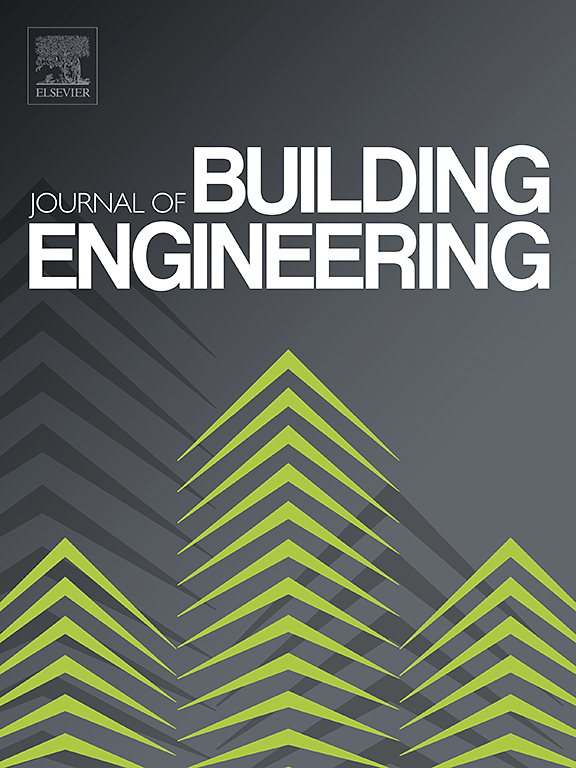用于垂直振动控制的调谐液柱气体阻尼器中柔性空气弹簧刚度的理论和实验研究
IF 6.7
2区 工程技术
Q1 CONSTRUCTION & BUILDING TECHNOLOGY
引用次数: 0
摘要
本研究调查了垂直调谐液柱气体阻尼器(VTLCGD)中的等效线性空气弹簧刚度对减少垂直结构振动的有效性,特别是考虑到不同的密封条件。VTLCGD 系统采用单密封垂直空气柱设计,可通过调整空气弹簧刚度灵活调节频率。它适用于低频结构,而传统的两端密封的 VTLCGD 设计效率较低。首先介绍了 VTLCGD 的几何构造和工作原理。利用液体动态平衡和压力-体积关系推导出运动方程,并通过不同长度 VTLCGD 的振动台试验验证了固有频率和控制力的表达式。利用压力数据进行了实验研究,以检查影响阻尼器性能的参数。然后,在悬臂地板上对该系统的减震性能进行了数值评估,该悬臂地板受到人体行走的影响。根据液体位移和固有频率的运动方程得出的数值结果与实验数据十分吻合,这证实了使用线性化空气弹簧刚度进行频率调整的有效性。还进一步研究了液体总长度和高度差对控制力的影响,并确定 VTLCGD 频率公式的多向指数为 1.2。与不受控的情况相比,VTLCGD 系统在悬臂地板上的加速度响应中实现了最大 52.63% 的减振效果。此外,还展示了密封条件变化导致的刚度变化,以验证阻尼器在宽频率范围内的适应性。本文章由计算机程序翻译,如有差异,请以英文原文为准。
Theoretical and experimental investigation of flexible air spring stiffness in a tuned liquid column gas damper for vertical vibration control
This study investigates the effectiveness of equivalent linear air spring stiffness in a Vertical Tuned Liquid Column Gas Damper (VTLCGD) for reducing vertical structural vibrations, particularly considering different sealing conditions. The VTLCGD system, designed with a single sealed vertical air column, allows flexible frequency tuning by adjusting the air spring stiffness. It aims to be used in low-frequency structures where conventional VTLCGD designs with two sealed ends are less efficient. The geometric configuration and working principle of the VTLCGD are first described. The equation of motion is derived using liquid dynamic equilibrium and the pressure-volume relationship, with expressions for natural frequency and control force validated through shaking table tests conducted with varying VTLCGD lengths. Experimental investigations are conducted to examine the parameters affecting damper performance using pressure data. The system's vibration reduction performance is then numerically evaluated on a cantilevered floor subjected to human walking. The numerical results, based on the equation of motion for liquid displacement and natural frequency, show good agreement with experimental data, which confirms the effectiveness of using linearized air spring stiffness for frequency tuning. The effects of total liquid length and height difference on control force are further investigated, and a polytropic index of 1.2 is determined for the VTLCGD frequency formula. The VTLCGD system achieves a maximum vibration reduction of 52.63 % in acceleration response on the cantilevered floor compared to the uncontrolled case. Moreover, the variation in stiffness due to changes in the sealing condition is presented to validate the damper's adaptability over a wide frequency range.
求助全文
通过发布文献求助,成功后即可免费获取论文全文。
去求助
来源期刊

Journal of building engineering
Engineering-Civil and Structural Engineering
CiteScore
10.00
自引率
12.50%
发文量
1901
审稿时长
35 days
期刊介绍:
The Journal of Building Engineering is an interdisciplinary journal that covers all aspects of science and technology concerned with the whole life cycle of the built environment; from the design phase through to construction, operation, performance, maintenance and its deterioration.
 求助内容:
求助内容: 应助结果提醒方式:
应助结果提醒方式:


